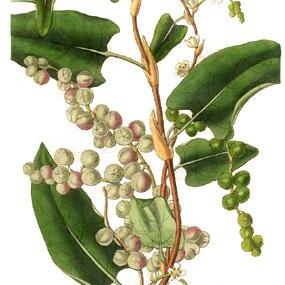Flowers polygamo-subdioecious (perfect in some spp. outside Panama), with short pedicels articulated at the base of the tepals, 1-5 (-many) in fascicles sub-tended by telescoped ochreolae. Tepals 5 (6, 4), subequal, greenish white, slightly accrescent and becoming more or less fused with the achene basally. Stamens 8 (-10), 1-3 mm. long, inserted on the base of the tepals, discrete or forming an inconspicuous annular disc, reduced or absent in pistillate flowers; anthers 4-locular, introrse, versatile. Ovary trigonous, reduced or absent in staminate flowers; styles 3, short, arcuate; stigmata capitate, lobate, or fimbrillate. Achenes mostly included, bluntly to acutely triquetrous, dark, lustrous, often puncticulate. Scramblers or low matted shrubs with usually glabrous, often sulcate stems. Leaves alternate, entire, apically acuminate to acute, basally hastate, cordate or acute, the blades usually exceeding the petioles; ochreae hyaline and conspicuous, deciduous. Inflorescences of axillary panicles, racemes or glomerules, occasionally leafy.
Plants dioec. or polygamous, in fascicles subtended by sheathing bracts; fascicles axillary, or in axillary or terminal spikes, racemes or panicles. Per. deeply 5-partite, or tepals united only at base. ♂ with 8 stamens, filaments filiform, anthers ovate in outline, pistil obsolescent. ♀ with trigonous ovary; styles 3; outer tepals often becoming enlarged, white, succulent, and enclosing the trigonous nutlike achene; staminodia thick to obsolete. Shrubs or woody lianes with alt. lvs and ochreate stipules. Genus of some 20 N.Z., Australian and S. American spp.

